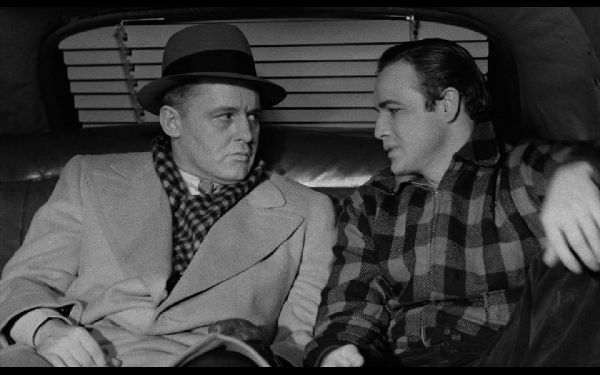On the Waterfront (1954) 
“Tender love…terrifying conflict!”

Director: Elia Kazan
Cast: Marlon Brando, Karl Malden, Lee J. Cobb
Synopsis: An ex-prize fighter turned longshoreman struggles to stand up to his corrupt union bosses.
It’s impossible to form an opinion about Elia Kazan’s On the Waterfront without first taking the film’s backstory into consideration. In their youth, Kazan and Budd Schulberg, the film’s writer, briefly flirted with communism, as did many of their peers, who went on to enjoy successful Hollywood careers before the McCarthy witch-hunts of the late 1940s and early 1950s. Many of those who, like Kazan, quickly rejected Communist principles, found themselves unable to work as a result of their inclusion on an unofficial Hollywood blacklist following their naming at the McCarthy hearings. Kazan and Schulberg, however, each saved their careers by agreeing to provide the names of those whom they knew to have at one time been a member of the Communist party. As a friendly witness with one of the highest profiles of those called to testify — he had, by this time, already directed such highly regarded movies as A Streetcar Named Desire (1951) and Viva Zapata! (1952) — Kazan’s willingness to comply with the hearings earned him widespread contempt from many within the industry. Kazan would later admit that On the Waterfront was largely a justification for his decision to testify before the McCarthy Committee.
Kazan’s alter ego in On the Waterfront is Terry Malloy (Marlon Brando), a young ‘bum’ who works the Hoboken docks and performs routine tasks for mobster union leader Johnny Friendly (Lee J. Cobb). We first meet Terry as he persuades his friend Joey Doyle to meet him on the roof of his apartment block so that he can return a lost pigeon to him. But waiting on the roof for his friend are a couple of Friendly’s henchman, who’ve been ordered to kill him because of his attempts to expose the corruption that riddles the longshoremen’s union that Friendly runs. Terry believed that Friendly’s men were only going to lean on the dead man, and begins to be troubled by his conscience.
The man’s murder also compels dockyard priest Father Barry (Karl Malden) to attempt to lead a longshoremen’s revolt against Friendly’s brutal regime by testifying before the Waterfront Crime Commission’s investigation into union corruption. Friendly sends Terry along to a meeting organised by Father Barry to find out what is said, but when the meeting is violently broken up by pro-Union thugs, Terry ushers Edie (Eva Marie Saint), the sister of Joey Doyle, to safety. Terry is instantly attracted to Edie, but her relationship to — and grieving for — the dead man serve only to deepen Terry’s sense of guilt and cause him to question his relationship with Friendly. However, Terry’s loyalties are torn by the fact that his older brother Charlie (Rod Steiger) is a key member of Friendly’s mob.
While there was nothing particularly new about Schulberg’s story of one man’s fight against the corrupt influence of a seemingly invulnerable organisation, the raw vitality and authenticity of the tale — which was aided by his extensive research work amongst the Hoboken docks which provide the backdrop and location of the movie — lent On the Waterfront an edgy air of realism that had never before been captured on film. But while the manner in which the movie was conceived and shot would have assured that it was a work of quality, it’s the performance of a stellar cast that elevates On the Waterfront to classic status.
The cast is led by Brando, then a young actor at the top of his game. Brando had to overcome his personal enmity for Kazan and his part in the McCarthy hearings in order to accept the role, but he also had the director to thank for pointing him in the direction of Lee Strasberg’s school of method acting, of which he became probably the foremost practitioner. In the role of Terry Malloy, Brando augments Schulberg’s dialogue with gestures and mannerisms that communicate the complex layer of thoughts and instincts that colour his character’s behaviour. Rod Steiger was another method actor, and the scene they share in the back of a cab has long since passed into movie lore, and is cited by some as one of cinema’s greatest scenes. The brilliance is in the small details, the way Terry gently pushes aside the gun his brother desperately pulls on him, the pain in his eyes as he delivers the much-imitated ‘contender’ speech, the inflection in his voice. This was a raw and immediate style of acting that was startling to behold because of its intensity and emotion.
As for Kazan’s assertion that he made the film to demonstrate that his testifying before the McCarthy hearings was an act of conscience rather than cowardice or self-preservation… well, I think the jury will never be decided on that one. But comparing the delivery of testimony that ruins the careers and lives of hard-working, blameless people with an act of selfless bravery that results in the overthrow of a cruel and unjust regime seems like something of a stretch to me…
(Reviewed 27th July 2012)
httpv://www.youtube.com/watch?v=xSImMMMf5nA
